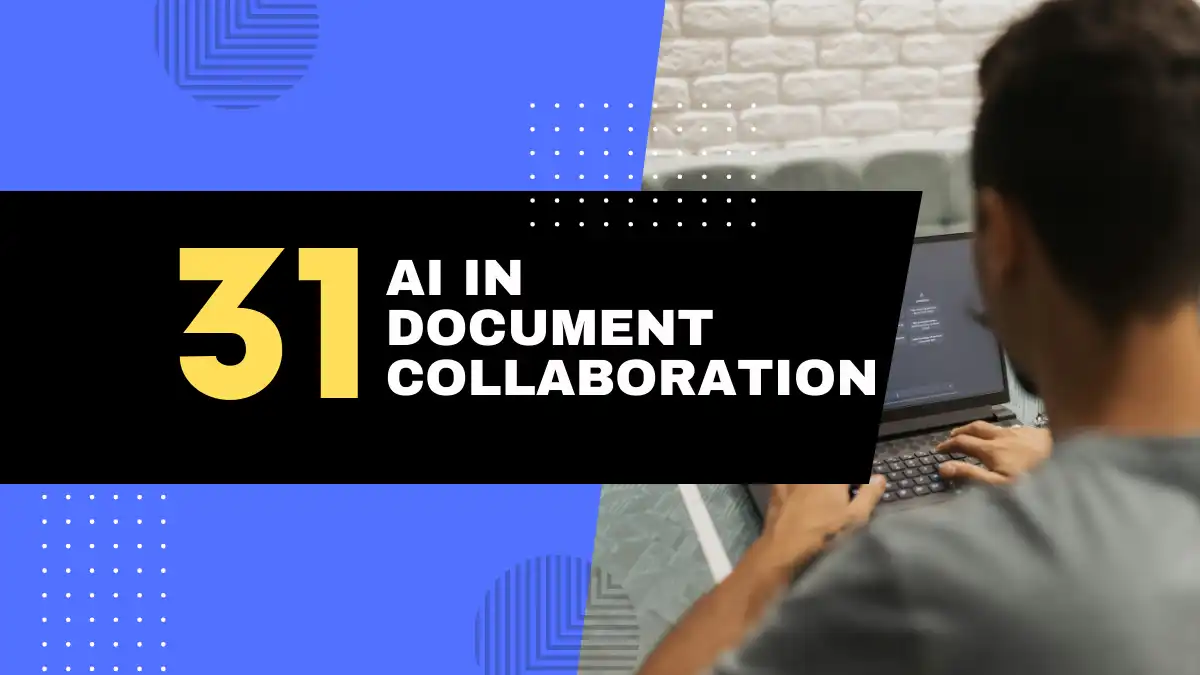
Have you ever found yourself drowning in a sea of document versions, struggling to keep track of who edited what and when? Or perhaps you’ve spent countless hours manually reviewing documents for errors, inconsistencies, or missing information? If so, you’re not alone. In today’s fast-paced digital workplace, collaboration on documents has become increasingly complex and time-consuming, often leading to frustration, miscommunication, and decreased productivity. The challenge of efficiently managing document workflows across teams, especially in remote or hybrid environments, has become a significant pain point for professionals across industries.
Enter AI in document collaboration—a game-changing approach that’s transforming how we create, edit, share, and manage documents. As we move through 2025, artificial intelligence has evolved from a buzzword to an essential component in modern document collaboration systems, offering solutions that were once thought impossible.
This comprehensive guide explores how AI document editing, AI-assisted collaboration, and AI-powered file sharing are revolutionizing workflows, boosting productivity, and creating more seamless collaborative experiences. Whether you’re a legal professional drowning in contract reviews, a marketing team struggling with content creation, or an academic researcher collaborating on complex papers, AI offers tools that can dramatically improve your document collaboration experience.
1. Understanding the Power of AI in Document Collaboration 💡
The integration of artificial intelligence into document collaboration platforms represents one of the most significant technological shifts in workplace productivity tools. But what exactly does AI bring to the table when it comes to document collaboration?
1.1 What is AI Document Editing?
AI document editing refers to the use of artificial intelligence technologies to enhance, streamline, and automate various aspects of the document creation and editing process. These AI-powered features can range from simple grammar checking to complex content generation and optimization.
Unlike traditional document editing tools that rely on predefined rules, AI document editing systems leverage machine learning algorithms to understand context, learn from patterns, and make intelligent suggestions that improve over time.
1.2 AI-driven Grammar and Style Checking ✓
Gone are the days of basic spell-checkers. Modern AI-powered grammar and style tools like Grammarly and ProWritingAid use sophisticated natural language processing (NLP) to:
- Detect subtle grammatical errors and stylistic inconsistencies
- Suggest tone adjustments based on your intended audience
- Identify potential clarity issues and recommend improvements
- Ensure consistency in terminology, formatting, and brand voice
According to a 2024 study by Workflow Productivity Research, professionals using AI-powered grammar tools report a 37% reduction in editing time and a 28% improvement in document quality.
1.3 Automated Content Summarization and Extraction 📝
AI excels at processing large volumes of information and extracting what matters most. Tools like Notion AI and Google Workspace’s Smart Canvas can:
- Generate concise summaries of lengthy documents
- Extract key points and action items from meeting notes
- Create executive summaries from detailed reports
- Identify and highlight critical information in legal documents
This capability is particularly valuable in information-heavy industries where professionals must quickly digest large amounts of content. A recent survey found that 64% of knowledge workers report spending over 5 hours weekly just summarizing and extracting information from documents.
1.4 AI for Translation Within Documents 🌎
As global collaboration increases, language barriers can hinder effective document collaboration. AI-powered translation features embedded within collaboration platforms like DeepL and Microsoft Translator offer:
- Real-time translation of document content
- Preservation of document formatting during translation
- Context-aware translations that maintain meaning
- Support for collaboration across dozens of languages
The accuracy of AI translation has improved dramatically, with neural machine translation now achieving up to 90% accuracy for many language pairs, according to the 2025 Global AI Language Processing Report.
1.5 Enhancing Collaboration with AI-Assisted Features
Beyond individual document editing, AI is transforming how teams work together on shared documents.
1.6 Real-time Co-authoring and AI Suggestions
Platforms like Google Docs and Microsoft 365 now incorporate AI to enhance real-time collaboration by:
- Suggesting content completions as you type
- Recommending relevant information from your organization’s knowledge base
- Identifying potential conflicts in simultaneous edits
- Offering contextual insights based on document content
A striking 72% of teams report that AI-assisted co-authoring has reduced document completion time by at least 25%, according to Collaboration Technology Quarterly’s 2025 report.
1.7 Intelligent Task Assignments and Workflow Automation
AI is streamlining document workflows through platforms like Asana and Monday.com that now offer:
- Automatic task assignment based on content and expertise
- Smart deadline recommendations based on project needs
- Workflow suggestions that optimize team collaboration
- Predictive resource allocation for document-heavy projects
| Workflow Aspect | Traditional Process | AI-Enhanced Process | Efficiency Gain |
|---|---|---|---|
| Task Assignment | Manual delegation | AI-based expertise matching | 43% faster |
| Deadline Setting | Arbitrary timeframes | Data-driven time estimates | 31% more accurate |
| Workflow Planning | Based on templates | Adaptive to project needs | 52% fewer bottlenecks |
| Resource Allocation | Fixed allocation | Dynamic and predictive | 37% better utilization |
1.8 AI-based Feedback and Approval Processes
The review and approval process has been transformed by AI tools like Adobe Workfront and Filestage that provide:
- Automated routing of documents to appropriate reviewers
- Prioritization of feedback based on impact and urgency
- Sentiment analysis of feedback to identify critical concerns
- Prediction of potential approval bottlenecks
Organizations implementing AI-assisted approval processes report a 41% reduction in document approval cycles and a 33% increase in stakeholder satisfaction.
1.9 AI-Powered File Sharing and Security 🔒
As document collaboration expands beyond organizational boundaries, AI is playing a crucial role in maintaining security while enabling seamless sharing.
1.10 Advanced Access Control and Permission Management
AI-enhanced security platforms like Box Shield and Varonis are revolutionizing document security through:
- Contextual access recommendations based on content sensitivity
- Anomaly detection in document access patterns
- Intelligent classification of documents for appropriate permission levels
- Automated permission adjustments based on project phases
Research indicates that organizations using AI for access control experience 57% fewer document security incidents while maintaining collaboration efficiency.
1.11 AI-driven Threat Detection and Data Loss Prevention
The integration of AI in security solutions provides powerful protection through:
- Real-time identification of suspicious document activities
- Prevention of accidental data leakage through smart content scanning
- Detection of potential insider threats through behavioral analysis
- Automated encryption recommendations based on document content
According to the 2025 Document Security Index, AI-powered data loss prevention tools have reduced sensitive data exposure incidents by 63% in organizations that have fully implemented these solutions.
1.12 Intelligent Version Control and Change Tracking
AI has significantly enhanced version control in tools like GitHub and Confluence by enabling:
- Smart merging of simultaneous edits with conflict resolution
- Automatic categorization of changes by significance
- Visualization of document evolution over time
- Identification of potential quality issues in document changes
Teams using AI-enhanced version control report 47% less time spent managing document versions and a 39% reduction in version-related errors.
2. Practical Applications of AI in Collaborative Workflows 🔍
The theoretical benefits of AI in document collaboration are compelling, but how are these technologies being applied in real-world scenarios? Let’s explore some practical applications across different industries.
2.1 Streamlining Legal Document Review with AI ⚖️
The legal industry, traditionally document-intensive, has seen transformative benefits from AI-assisted collaboration.
2.2 Contract Analysis and Clause Identification
Legal teams are leveraging specialized AI tools like Kira Systems and LexisNexis to:
- Automatically identify and extract key clauses from contracts
- Compare contract language against approved templates
- Flag non-standard or high-risk provisions
- Ensure compliance with regulatory requirements
Law firms implementing AI for contract review report processing documents 65% faster while identifying 30% more potential issues than manual review alone.
2.3 Due Diligence Automation
During mergers and acquisitions, due diligence processes involve reviewing thousands of documents. AI solutions like Luminance and Dataroom enable:
- Rapid classification and organization of due diligence documents
- Identification of material risks across large document sets
- Extraction of key terms and commitments from agreements
- Collaborative annotation and discussion of critical findings
A 2025 study of M&A processes found that AI-assisted due diligence reduced review time by 59% while improving accuracy by 44%.
2.4 Boosting Productivity in Marketing Content Creation 📢
Marketing teams are embracing AI to streamline content creation and collaboration.
2.5 AI-generated Content Suggestions and Optimization
Marketing platforms like Jasper and Copysmith provide:
- Data-driven suggestions for content improvements
- SEO optimization recommendations in real-time
- Brand voice consistency checks across team members
- Headline and call-to-action testing suggestions
Marketing teams using AI-assisted content collaboration report a 52% increase in content production volume and a 37% improvement in engagement metrics.
2.6 Automated Content Distribution and Analysis
AI tools are streamlining the content workflow beyond creation through platforms like HubSpot and Hootsuite that offer:
- Smart scheduling based on audience engagement patterns
- Channel-specific content adaptation recommendations
- Performance prediction before publication
- Collaborative performance analysis with automated insights
Organizations using AI for content distribution report a 43% improvement in content performance and 68% better alignment between content teams.
2.7 Improving Academic Research Collaboration 🎓
The academic community has embraced AI-assisted collaboration to enhance research quality and efficiency.
2.8 AI-assisted Literature Review and Citation Management
Researchers are using specialized tools like Zotero AI and Elicit to:
- Automatically identify relevant research based on manuscript content
- Suggest missing citations and research gaps
- Check citation accuracy and formatting
- Enable collaborative annotation of research papers
Academic institutions implementing AI citation tools report a 49% reduction in citation errors and a 37% reduction in literature review time.
2.9 Collaborative Data Analysis and Visualization
Research teams are leveraging AI through platforms like Jupyter AI and Observable to:
- Generate code for data analysis based on natural language descriptions
- Suggest appropriate visualization methods for specific data types
- Enable real-time collaborative analysis across distributed teams
- Automate the documentation of analysis methods
According to a 2025 survey of research institutions, teams using AI-assisted data collaboration tools published 41% more papers and secured 35% more grant funding.
3. Overcoming Challenges and Looking to the Future of AI-Assisted Collaboration 🔮
While AI offers tremendous benefits for document collaboration, organizations must navigate several challenges to realize its full potential.
3.1 Addressing Data Privacy and Security Concerns 🛡️
As AI systems process sensitive documents, privacy and security considerations become paramount.
3.2 Ethical Considerations in AI-driven Document Analysis
Organizations implementing AI document collaboration must address:
- Transparency in how AI processes document data
- User consent for AI analysis of sensitive content
- Bias mitigation in AI recommendations
- Appropriate handling of personally identifiable information
A recent survey found that 73% of organizations have established specific ethical guidelines for AI use in document collaboration.
3.3 Best Practices for Secure AI Implementation
Security experts recommend several approaches to ensure secure AI document collaboration:
- End-to-end encryption for all document processing
- Local processing of sensitive documents when possible
- Clear data retention policies for AI training data
- Regular security audits of AI systems and processes
Organizations that implemented these best practices reported 76% fewer security incidents related to AI document systems.
3.4 The Evolution of AI in Real-Time Collaboration
Looking ahead, several emerging trends will shape the future of AI in document collaboration.
3.5 Integration with Emerging Technologies (e.g., VR/AR)
The combination of AI and immersive technologies promises to transform document collaboration through:
- Virtual document collaboration spaces powered by AI
- Augmented reality annotations and suggestions
- Multi-modal document interaction combining voice, gesture, and text
- AI facilitators for immersive collaborative sessions
Early adopters of VR/AR document collaboration report 62% higher engagement and 47% better retention of information.
3.6 Predictive Collaboration and Workflow Optimization
Next-generation AI will anticipate collaboration needs through:
- Proactive document creation based on upcoming meetings or projects
- Suggestion of optimal collaborator combinations for specific tasks
- Dynamic reorganization of workflows based on changing priorities
- Predictive resource allocation to prevent bottlenecks
Organizations piloting predictive collaboration systems report a 53% reduction in project delays and a 41% improvement in team satisfaction.
3.7 The Future of AI-powered File Sharing
File sharing is evolving rapidly with AI enhancement through:
- Context-aware document discovery across repositories
- Automatic formatting adaptation for cross-platform compatibility
- Predictive caching of documents likely to be needed
- Smart compression optimized for specific content types
By 2026, analysts predict that 80% of enterprise file sharing will incorporate some form of AI-powered enhancement.
3.8 Increased Automation
Document workflows will see greater automation through:
- End-to-end document lifecycle management
- Trigger-based document generation and distribution
- Autonomous quality assurance and compliance checking
- Self-optimizing document templates that evolve based on usage
Organizations with highly automated document workflows report 67% faster document processing and 43% lower administrative costs.
3.9 Improved Cross-Platform Collaboration
AI will bridge gaps between different platforms through:
- Seamless format conversion preserving document intelligence
- Cross-platform identity and permission synchronization
- Consistent collaboration experience across devices and systems
- Intelligent bridging between incompatible collaboration tools
Teams using AI-powered cross-platform collaboration report 58% less friction when working across organizational boundaries.
4. Frequently Asked Questions (FAQ) About AI in Document Collaboration ❓
4.1 How does AI improve document version control?
AI enhances version control by intelligently tracking meaningful changes rather than simply logging all edits. It can identify significant modifications, categorize changes by type (e.g., structural, content, formatting), and even predict potential conflicts between different versions. Advanced AI systems can provide “smart diffs” that highlight changes in context and suggest optimal merge strategies when conflicts arise.
4.2 What are the best AI tools for collaborative editing?
While “best” depends on specific needs, several standout options in 2025 include:
- Google Workspace with Smart Canvas: Excellent for general-purpose document collaboration with powerful AI suggestions
- Microsoft 365 Copilot: Strong integration across the Microsoft ecosystem with advanced AI capabilities
- Notion AI: Excellent for knowledge management with powerful summarization and organization features
- Coda AI: Unique combination of documents and structured data with AI assistance
- ClickUp AI: Strong project management integration with AI document capabilities
4.3 Is AI-assisted collaboration secure?
AI-assisted collaboration can be secure when implemented properly, but requires thoughtful consideration of:
- Data encryption during processing and transmission
- Clear privacy policies regarding AI training data
- Compliance with regional regulations like GDPR, CCPA, etc.
- Regular security audits and vulnerability assessments
- Appropriate access controls for AI systems and data
Organizations should conduct thorough security assessments before implementing AI document collaboration tools, especially for sensitive information.
4.4 Can AI help with document translation?
Absolutely. AI-powered translation has advanced significantly, offering:
- Near real-time translation of documents across 100+ languages
- Preservation of document formatting and structure during translation
- Context-aware translation that maintains industry-specific terminology
- Collaborative review tools for human refinement of AI translations
Modern neural machine translation achieves over 90% accuracy for many language pairs and continues to improve. For critical documents, human review is still recommended, but AI dramatically accelerates the process.
4.5 What are the benefits of AI-powered file sharing?
AI-powered file sharing offers numerous advantages:
- Intelligent access control based on content and context
- Proactive security measures that identify potential threats
- Smart organization that makes finding documents intuitive
- Predictive sharing that anticipates recipient needs
- Cross-platform compatibility with format preservation
- Automated version reconciliation when conflicts arise
According to recent research, organizations implementing AI-powered file sharing report 46% faster document retrieval and 39% fewer permission-related issues.
Conclusion 🏁
As we’ve explored throughout this article, AI in document collaboration is fundamentally transforming how we create, edit, share, and manage documents. The integration of AI document editing, AI-assisted collaboration, and AI-powered file sharing offers unprecedented opportunities to enhance productivity, improve document quality, and streamline workflows across organizations of all types.
From legal teams speeding through contract reviews to marketing departments collaborating on content to researchers jointly analyzing complex data, AI is serving as both an assistant and an enhancer of human capabilities. Rather than replacing human collaboration, AI amplifies it, handling routine tasks while enabling people to focus on creative and strategic aspects of document work.
As we look to the future, the combination of AI with emerging technologies like AR/VR promises even more transformative changes to collaborative document experiences. Organizations that embrace these technologies thoughtfully—with appropriate attention to security, ethics, and user experience—will gain significant competitive advantages in an increasingly digital workplace.
The revolution in AI document collaboration isn’t just about technology; it’s about reimagining how we work together to create, share, and leverage information in the digital age. For professionals across industries, understanding and adopting these AI-powered approaches to document collaboration represents not just an opportunity but increasingly a necessity in today’s fast-paced business environment.
Are you ready to transform your document collaboration with AI? The tools and approaches outlined in this article provide a roadmap for getting started—whether you’re taking your first steps with AI-assisted grammar checking or implementing comprehensive AI-powered document workflows across your organization.
Looking for more document collaboration tools? Check out our related guides on The Ultimate Guide to Collaborative Document Tools: Software, Features, and Best Practices.






